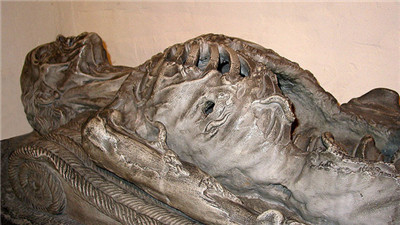4、It Changed World Culture
改變了世界文明
The plague’s spread left survivors in a world forever changed. It brought a new awareness of death and mortality, and the artists of the time turned to painting what they saw around them. In eras of plague, particularly the 14th and 16th centuries, art got much darker. Religious paintings often featured the dead. Hell was depicted more often than heaven—and oftentimes, it was a hell on Earth.
瘟疫的傳播留給幸存者是永遠改變了的世界。讓人們對死亡和必死命運有了新的理解,因此,這個時期的畫家開始繪制他們身邊所看到的東西。在瘟疫流行的時代,尤其是14世紀和16世紀期間,藝術的格調也更加黑暗。宗教性質的繪畫通常也以死亡為主。地獄比天堂出現的次數還多,通常他們繪制的都是人間地獄。

One of the eeriest styles of art to come out of the 16th century was a change in tomb and gravestone design. Before, people were often shown at rest. Now, artists introduced the transi, a form of sculpture that more accurately showed the dead rotting flesh and skeletal form.
16世紀還生成一種非常恐怖的藝術,通常體現在墳墓、墓碑設計的改變上。之前,人們通常以安歇的形式出現。而這時,畫家們介紹死亡通常以“轉變”為主題來表現,這一類型的壁畫更加直觀精確的描繪出了尸體的腐爛和骷髏的形成過程。
The plague had another strange effect on the world’s art and literature, and that wasn’t just a change in content but in style and quality. When the plague struck, it attacked without heed to a person’s standing, status, or occupation. Many great masters died in the midst of teaching their proteges. That in turn led to a dynamic shift in the quality and techniques present in art from the time.
瘟疫的還影響世界的藝術與文化,這不僅僅是表現在內容上,還包括了形式和質量上。當瘟疫來臨時,不管你處于什么樣的立場、地位和職位,都不能幸免。許多偉大的大師都死在給門徒教學的過程中。這反過來又導致了那個時代的藝術在質量上和技術上的轉變。











